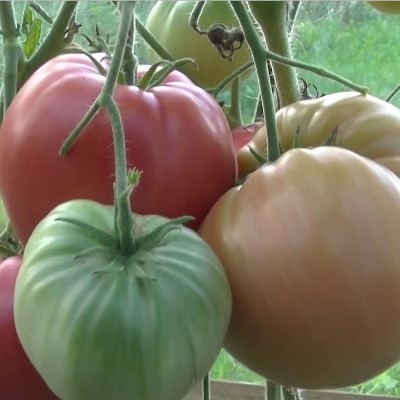
- Authors: Yugoslavia
- Category: grade
- Growth type: indeterminate
- Appointment: fresh consumption
- Ripening period: mid-season
- Bush size: tall
- Bush height, cm: 150-180
- Bush characteristic: powerful
- Ripe fruit color: pink
- Fruit shape: heart-shaped or flat-round
The selection of the Balkan countries is not well known in Russia. However, the plant varieties she developed deserve the attention of domestic farmers at least. This culture is a vivid confirmation of this.
Description of the variety
Tomato Yasha Yugoslavsky, as it is easy to understand, was bred in Yugoslavia itself. The experience of using it is already quite large. This is a classic indeterminate tomato, because its bushes will grow violently and require careful adjustment. Plants reach a height of 1.5-1.8 m. They are visually powerful.
The main qualities of the fruit
When ripe, the berries of this variety are pink in color. They are large. The average weight of fruits is about 300-350 g. A heart-shaped shape may be typical for them. And also there are flat-round tomatoes.
Taste characteristics
For Yasha Yugoslavsky, pleasant sweetness is typical. Its flesh is fleshy. Its juiciness is also emphasized in the official description. And also it is necessary to take into account that this tomato is dense inside. Taken together, these qualities form a brilliant ensemble.
Ripening and fruiting
Yasha Yugoslavsky is considered a mid-season tomato. He has a prolonged fruiting, which is very popular with those who love to receive berries for a long time. Harvesting, as indicated in the official description, will be possible until late autumn.
Yield
A number of sources indicate that productivity can reach 5 kg per 1 sq. m. But this is possible only with strict adherence to agrotechnical requirements. It is also necessary to understand that much depends on weather conditions.
The timing of planting seedlings and planting in the ground
They must be determined individually. Approximately 60-65 days should remain before the approximate transfer to open ground. The climate of a particular region is decisive. And also it is worth paying attention to the condition of the plants before planting. It is also very useful to check how really the soil has warmed up.

Growing tomato seedlings is an extremely important process, because it largely depends on whether the gardener will be able to harvest at all. All aspects must be taken into account, from seedbed preparation to planting in the ground.
Landing scheme
There are no recommendations on this score in the available sources. Gardeners will have to make their own decisions at their own risk. It is most correct to be guided by the universal requirements for planting tomatoes, in general. There are only indications of the general plan that for 1 sq. m should not be more than 3 bushes. Seeds are pre-tested for germination (with a standard salt water test).

Growing and care
Stepchildren that interfere with the development of plants should be removed as regularly as possible. Since culture is indeterminate, it will be impossible to do without a garter to the supports. Preferred plant formation in 1-2 stems. Refusal to formulate has serious negative consequences. The planting material is advised to be etched with potassium permanganate, rinsed and treated with growth activators.
Sand and peat must be laid in the ground for seedlings. The seeds should be buried 1-1.5 cm. After germination of 50% of the seedlings, glass or polyethylene is removed. It is necessary to dive seedlings when the 2nd true leaf appears. Mulching is strictly required.
The stepsons should be removed at the very end of July. Additional pinching is undesirable, it can injure the bushes. The amount of removal is up to 4-5 cm. It is necessary to water Yasha Yugoslavsky in the open field twice a week. When cultivated in a shelter, it is usually enough once a week.
Rainwater is the ideal choice. If it is not there, you can just defend tap or artesian water. With strong heat, the leaves can "burn"; also the fruits turn yellow or turn green. However, the taste of the crop does not deteriorate in any significant way from this.
Tomato brushes require garters on a regular basis. It's all about their low strength. Damage under the weight of the fruit is likely. So far, Yasha Yugoslavsky is a rare guest in Russian gardens. But we can already say that it is worth the attention of experienced amateurs.




A plant needs different micronutrients at each stage of growth. All fertilizers can be divided into two groups: mineral and organic. Folk remedies are often used: iodine, yeast, bird droppings, eggshells.
It is important to observe the rate and period of feeding. This also applies to folk remedies and organic fertilizers.



























































































